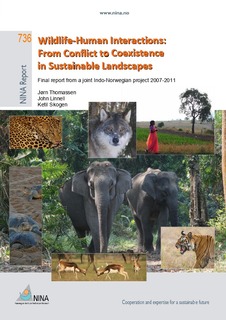| dc.description.abstract | Thomassen, J., Linnell, J. & Skogen, K. 2011. Wildlife-Human In teractions: From Co nflict to
Coexistence in Sustainable La ndscapes. Final report from a j oint Indo-Norwegian project 2007-
2011. - NINA Report 736. 83 pp.
The last three decades of the 20th century were witness to a dramatic turn around in policy towards the environment and conservation of biodiversity and many international conventions were ratified by most of the world countries. Recent paradigms have attempted to make connections between biodiversity conservation and human well-being. However, not all biodiversity is associated with human well-being and many species can create direct and severe conflicts with human interests. As a consequence, wildlife-human conflicts are currently recognized as a serious impediment to the implementation of conservation plans for species recovery and the establishment or management of protected areas in many developing countries such as India and even in parts of Norway. This background was important in 2007 when the Norwegian Institute for Nature Research (NINA) and the Centre for Ecological Science (CES) of the Indian Institute of Science (IISc), together with the Royal Norwegian Embassy (New Delhi) initiated a collaborative research project on Human – Wildlife conflicts. Several other institutions in India and Norway were subcontracted as collaborators. The overall goal of the project has been to understand the dynamics of wildlife human interactions in India and Norway (in a sample of multiuse landscapes) and develop mechanisms of coexistence suitable to the countries. From the outset it was recognized as being important to include both natural science and social science perspectives into the project. The main focus in the project was put on a few species such as elephant, blackbuck and other herbivores, leopard, wolf, turtles – all species that regularly come into conflict with humans, but which reflect the diversity of forms these conflicts can take. A large part of India was covered in the various studies on these species and in the social science research component of the project. The various project activities included. All India survey of Human Wildlife Conflicts: questionnaire survey delivered to all Forestry Department Divisions in India (chapter 3.2.1). Elephants in Orissa: state wide mapping of spatial distribution of elephants in conflicts (chapter 3.2.2). Elephants in west Bengal: identification of conflict around migration corridors between fragmented forest patches (chapter 3.2.3). Nilgiri hills: a broad study of human-wildlife conflicts in one of the largest and most intact forested areas in India (chapter 3.2.4). Leopards in Akole: a study of leopards living in croplands and their interactions with local people (chapter 3.2.5). Wolves, dogs and rabies in Nannaj: a survey of the extent of rabies infection in wild canids and level of transmission to humans (chapter 3.2.6). Blackbuck in Nannaj: a study of the patterns of crop damage around the Great Indian Bustard Wildlife Sanctuary (chapter 3.2.7). Crop-raiding around Tadoba-Andhari tiger reserve: an exploration of how different herbivores raid crops with increasing distance from the protected area border (chapter 3.2.8). Sea turtles on the Lakshadweep Islands and Orissa coast: a study of conflicts between local fishers and turtles concerning resource access (chapter 3.2.9 and 3.2.10). Human Wildlife conflicts across different landscapes: a framework for examining social, political and economic issues and a preliminary comparison between sites (chapter 3.2.11) Monkeys in Terhi Garhwal: study of crop raiding by monkeys (chapter 3.2.12). Todas and sacred buffalos: a study of conflicts associated with tiger predation on sacred buffalos and transformation of culturally valued grassland habitats to forest (chapter 3.2.13). Human - large carnivore interactions in Akole, north-western Maharashtra: how people and wildlife, specifically large carnivores, coexist in a human-dominated rural landscape in western India, which is outside the protected area network (chapter 3.2.14) | nb_NO |
